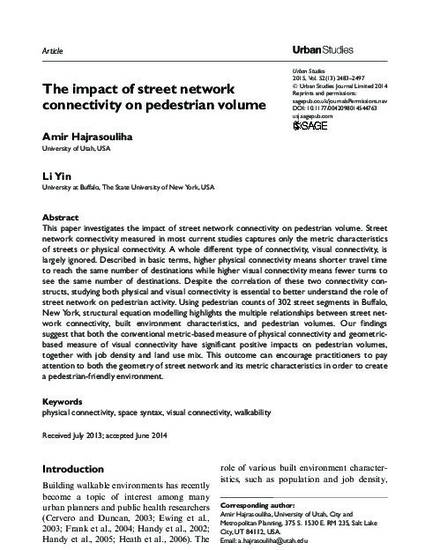
Article
The impact of street network connectivity on pedestrian volume
Urban Studies
(2014)
Abstract
This paper investigates the impact of street network connectivity on pedestrian volume. Street network connectivity measured in most current studies captures only the metric characteristics of streets or physical connectivity. A whole different type of connectivity, visual connectivity, is largely ignored. Described in basic terms, higher physical connectivity means shorter travel time to reach the same number of destinations while higher visual connectivity means fewer turns to see the same number of destinations. Despite the correlation of these two connectivity constructs, studying both physical and visual connectivity is essential to better understand the role of street network on pedestrian activity. Using pedestrian counts of 302 street segments in Buffalo, New York, structural equation modelling highlights the multiple relationships between street network connectivity, built environment characteristics, and pedestrian volumes. Our findings suggest that both the conventional metric-based measure of physical connectivity and geometric-based measure of visual connectivity have significant positive impacts on pedestrian volumes, together with job density and land use mix. This outcome can encourage practitioners to pay attention to both the geometry of street network and its metric characteristics in order to create a pedestrian-friendly environment.
Keywords
- physical connectivity,
- space syntax,
- visual connectivity,
- walkability
Disciplines
Publication Date
Spring June, 2014
DOI
10.1177/0042098014544763
Citation Information
Amir Hajrasouliha and Li Yin. "The impact of street network connectivity on pedestrian volume" Urban Studies Vol. 52 Iss. 13 (2014) Available at: http://works.bepress.com/hajrasouliha/1/
